外交声明翻译共36页
第四单元 外交宣言的翻译

Unit 4 The Translation of Diplomatic Declarations外交宣言的翻译国家元首与政府首脑的翻译中文:国籍+职务+姓名如:越南社会主义共和国总理文凯英文:姓名+职务+国籍如:Phan Van Khai, Prime Minister, Socialist Republic of Viet NamRemarks:(首相是内阁总理大臣的简称,日本人平时也是称呼首相的,只有重大场合,如觐见天皇,大选结束,重要外事活动才称呼内阁总理大臣,就像中国唐、宋两朝,宰相的正式称呼是同中书门下三品或者是同中书门下平章事,但是平时都是称呼为“宰相”一样。
)On September 20th,2006, Abe Shinzo was elected as the new President of Jimindo party, and successfully took the post of Japan’s prime minister on September 26th.2006年9月20日,安倍晋三当选为新一任自民党总裁,并于9月26日出任新一届日本内阁总理大臣。
伊斯兰教国家里:“哈里发”(Caliph)是宗教领袖“苏丹”(Sultan)是世俗统治者2.外交文书四字格的实用汉语四字格是经过长期锤炼而成的,是社会语言和文化的重要组成部分,是汉语语库里的一块瑰宝,体现出中华民族的智慧,体现了汉语语言的博大精深。
四字格一般都有言简意赅,整齐匀称,形象生动的特点。
汉语四字格是汉语中特有的词语组合现象,它不仅包含成语,还包含非固定的四字结构。
汉语成语有百分之九十七采用四字格。
四字格以其巨大的优势在英译汉中得到了广泛的运用。
外交文书中的翻译也很常见。
例1To Henry Kissinger, for whose wise counsel and dedicated services far beyond he call of duty I shall always remain grateful. From his friend, Richard Nixon赠言亨利.基辛格你的朋友:理查德.尼克松例21.The development goals set out in The UN Millennium Declaration should be fulfilled so as to build, at an early date, a world where reciprocity, balanced development, win-win cooperation and common prosperity prevail.联合国《千年宣言》确定的发展目标应该切实得到落实,2. As we cast our eyes over the horizon and towards the future, one thing is absolutely clear: China, with its ancient civilization and renewed economic and political vigor, will have aprofound influence on the new world of the 21st century.事是非常清楚的:中国拥有悠久的古代文明史和新的经济和政治活力,将对21 世纪的新世界产生深远的影响。
中国外交官霸气发言英语版

中国外交官霸气发言英语版倒打一耙是不行的!You can't blame this problem on somebody else.Tips: blame sth. on sb. 把某事归咎到某人身上。
我把你们想得太好了,我们认为你们会遵守基本的外交礼节Well, I think we thought too well of the United States, we thought the US side will follow the necessary diplomatic protocols.Tips:diplomatic protocols /ˌdɪplə'mætɪk/ /'protə'kɔlz/ 外交礼节diplomat 外交官所以,我们刚才必须阐明我们的立场。
so for China, it was necessary that we make our position clear.我现在讲一句,你们没有资格在中国的面前说,你们从实力的地位出发,和中国谈话。
so let me say here that in front of the Chinese side, the United States does not have the qualification to say that it wants to speak to China from a position of strength。
no qulification 没有资格!from a position of strength 从实力的地位出发strength /strɛŋθ/既可以表示人的力气,也可以表示面试中常被问到的长处,在这里表示一个国家的实力和影响力中方过去、将来都绝不会接受美国方面的无端指责China has never accepted unprovoked accusations from the US and will never accept any in the future.unprovoked /'ʌnprə'vokt/ 无缘无故的、无端的(攻击、指责)【也有外媒用的表示是:unwarranted accusations 莫须有的,这个词也很好】accusation 指控我们要求美方放弃动辄干涉中国内政的霸权行径We ask the US to give up on interfering in China's internal affairs at will.interfere in ... 妨碍、干涉internal affairs 内政at will : at any time that you want or choose 动辄、随心所欲He can cry at will. 他随时随地可以开哭。
外交部发言 翻译
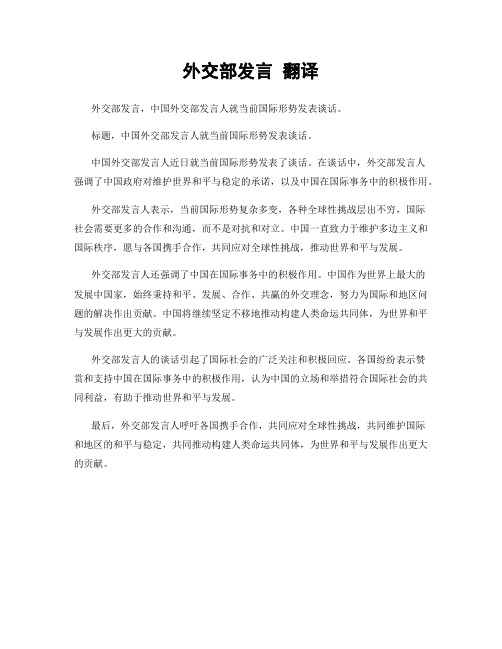
外交部发言翻译
外交部发言,中国外交部发言人就当前国际形势发表谈话。
标题,中国外交部发言人就当前国际形势发表谈话。
中国外交部发言人近日就当前国际形势发表了谈话。
在谈话中,外交部发言人
强调了中国政府对维护世界和平与稳定的承诺,以及中国在国际事务中的积极作用。
外交部发言人表示,当前国际形势复杂多变,各种全球性挑战层出不穷,国际
社会需要更多的合作和沟通,而不是对抗和对立。
中国一直致力于维护多边主义和国际秩序,愿与各国携手合作,共同应对全球性挑战,推动世界和平与发展。
外交部发言人还强调了中国在国际事务中的积极作用。
中国作为世界上最大的
发展中国家,始终秉持和平、发展、合作、共赢的外交理念,努力为国际和地区问题的解决作出贡献。
中国将继续坚定不移地推动构建人类命运共同体,为世界和平与发展作出更大的贡献。
外交部发言人的谈话引起了国际社会的广泛关注和积极回应。
各国纷纷表示赞
赏和支持中国在国际事务中的积极作用,认为中国的立场和举措符合国际社会的共同利益,有助于推动世界和平与发展。
最后,外交部发言人呼吁各国携手合作,共同应对全球性挑战,共同维护国际
和地区的和平与稳定,共同推动构建人类命运共同体,为世界和平与发展作出更大的贡献。
外交宣言、白皮书翻译PPT文档24页
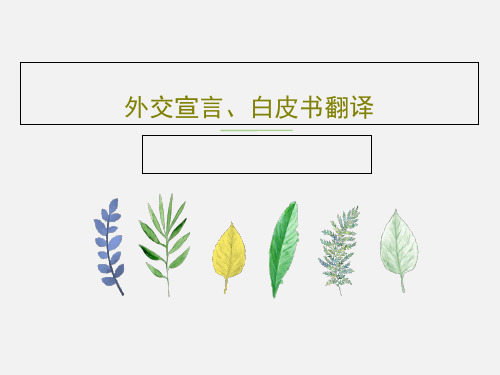
别人所说的话,则需要头脑。—— 玛丽·佩蒂博恩·普尔
44、卓越的人一大优点是:在不利与艰 难的遭遇里百折不饶。——贝多芬
45、自己的饭量自己知道。——苏联
外交宣言、白皮书翻译
56、死去何所道,托体同山阿。 57、春秋多佳日,登高赋新诗。 58、种豆南山下,草盛豆苗稀。晨兴 理荒秽 ,带月 荷锄归 。道狭 草木长 ,夕露 沾我衣 。衣沾 不足惜 ,但使 愿无违 。 59、相见无杂言,但道桑麻长。 60、迢迢新秋夕,亭亭月将圆。
41、学问是异常珍贵的东西,从任何源泉吸 收都不可耻。——阿卜·日·法拉兹
欧盟涉华内政声明全文翻译
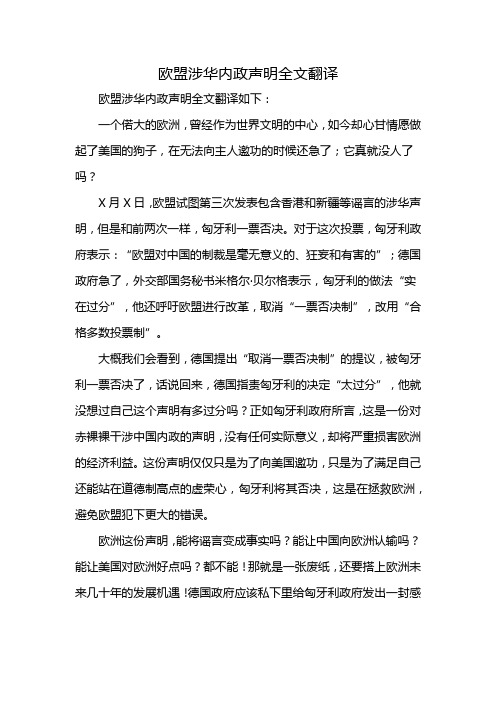
欧盟涉华内政声明全文翻译欧盟涉华内政声明全文翻译如下:一个偌大的欧洲,曾经作为世界文明的中心,如今却心甘情愿做起了美国的狗子,在无法向主人邀功的时候还急了;它真就没人了吗?X月X日,欧盟试图第三次发表包含香港和新疆等谣言的涉华声明,但是和前两次一样,匈牙利一票否决。
对于这次投票,匈牙利政府表示:“欧盟对中国的制裁是毫无意义的、狂妄和有害的”;德国政府急了,外交部国务秘书米格尔·贝尔格表示,匈牙利的做法“实在过分”,他还呼吁欧盟进行改革,取消“一票否决制”,改用“合格多数投票制”。
大概我们会看到,德国提出“取消一票否决制”的提议,被匈牙利一票否决了,话说回来,德国指责匈牙利的决定“太过分”,他就没想过自己这个声明有多过分吗?正如匈牙利政府所言,这是一份对赤裸裸干涉中国内政的声明,没有任何实际意义,却将严重损害欧洲的经济利益。
这份声明仅仅只是为了向美国邀功,只是为了满足自己还能站在道德制高点的虚荣心,匈牙利将其否决,这是在拯救欧洲,避免欧盟犯下更大的错误。
欧洲这份声明,能将谣言变成事实吗?能让中国向欧洲认输吗?能让美国对欧洲好点吗?都不能!那就是一张废纸,还要搭上欧洲未来几十年的发展机遇!德国政府应该私下里给匈牙利政府发出一封感谢信,感谢他为拯救欧洲的前途命运作出的牺牲和努力,没准它还真就如此。
不管这些欧洲政客的真实想法是什么,我们只看到一个偌大的欧洲,5亿人口的欧盟,敢站在正义和公理的立场上仗义执言的,没有几个人。
根据国际货币基金会的最新预测,中国GDP超越美国成为第一大经济体的日子,又被提前了两年,被提前到XXXX年;德国前总理施罗德一直在告诫欧洲人,不要忘记中国市场的能量,“欧洲不应该对中国施加任何的制裁,因为中国作为世界经济发展引擎的重要性毋庸置疑,西方想要孤立中国的企图不可能成功”。
这是百年未有之大变局;欧洲如果能够放下傲慢的心态,以平等的姿态看待崛起中的东方大国,他将会看到一个更加美好的世界和广阔的未来;但是它能做到吗?如果真的能做到,那就不是典型的老欧洲了。
二、外交公报的翻译

(4)若公报中有具体时间,则根据具体事情的时间选用时态。
双方领导人对今年2月(即2004年2月——编者注)在北京成功举行的中欧
双方领导人同意中欧在能源战略、政策、发展与改革等方面加强对
话机制,积极开展交流与合作。双方领导人鼓励有关部门尽快就和平 利用核能合作协定开始磋商。
Leaders also agreed to enhance the dialogue mechanism in the area of
energy strategy, policy, development and reform with a view to activating exchanges and cooperation. They encouraged the departments concerned to start consultations as soon as possible on an agreement on cooperation in the field of peaceful use of nuclear energy.
平与发展的不确定因素增多。中欧双方应本着互信、互利、平等、协作 的原则共同维护国际安全,加强联合国在维护世界和平、稳定与安全及 促进可持续发展方面的重要作用,推动多边主义和国际关系民主化。
Leaders were of the view that the current international situation was
新闻公报、联合新闻公报等。“联合公报”要比“联合新闻公报”
更正式一些。
外交公报翻译分析
1. 紧扣原文内涵实质准确措辞
(Accurate Diction by keeping Closely to the Connotation of the Source Language)
英文版声明范文
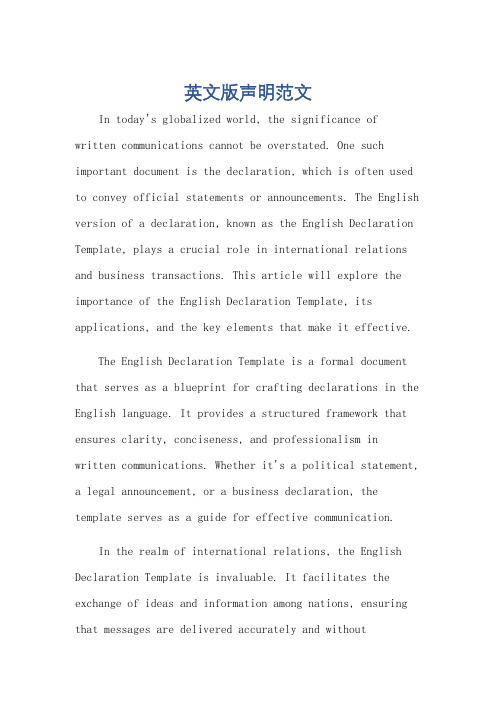
英文版声明范文In today's globalized world, the significance ofwritten communications cannot be overstated. One such important document is the declaration, which is often used to convey official statements or announcements. The English version of a declaration, known as the English Declaration Template, plays a crucial role in international relations and business transactions. This article will explore the importance of the English Declaration Template, its applications, and the key elements that make it effective. The English Declaration Template is a formal document that serves as a blueprint for crafting declarations in the English language. It provides a structured framework that ensures clarity, conciseness, and professionalism inwritten communications. Whether it's a political statement, a legal announcement, or a business declaration, the template serves as a guide for effective communication.In the realm of international relations, the English Declaration Template is invaluable. It facilitates the exchange of ideas and information among nations, ensuring that messages are delivered accurately and withoutambiguity. This is particularly important when dealing with sensitive topics such as diplomatic relations, trade agreements, and international law. The use of a standardized template ensures that all parties involved understand the nature and implications of the statements made.In the business world, the English Declaration Template is also highly regarded. It is often used in contracts, agreements, and other legal documents to clarify terms and conditions. The template ensures that all parties are on the same page, understanding their rights and responsibilities. This not only fosters trust but also reduces the risk of misunderstandings and disputes.Moreover, the template can be customized to fitspecific needs. Whether it's a declaration for a specific event, a press release announcing a new product, or a statement regarding a company's policies, the template can be tailored to reflect the unique context and objectives of the communication.The key elements of an effective English Declaration Template include clarity, conciseness, and professionalism.Clarity is achieved by using simple language and avoiding jargon or technical terms that may confuse the reader. Conciseness ensures that the message is direct and to the point, avoiding unnecessary verbosity. Professionalism is maintained by adhering to a formal tone and style, reflecting the seriousness and importance of the subject matter.In conclusion, the English Declaration Template plays a pivotal role in ensuring effective written communication in both international relations and business transactions. It provides a structured framework for crafting declarations that are clear, concise, and professional. By utilizingthis template, individuals and organizations can ensurethat their messages are delivered accurately and understood by all parties involved.**英文版声明范文的重要性与应用**在当今全球化的世界中,书面沟通的重要性不言而喻。
政论外宣常用外交辞令翻译
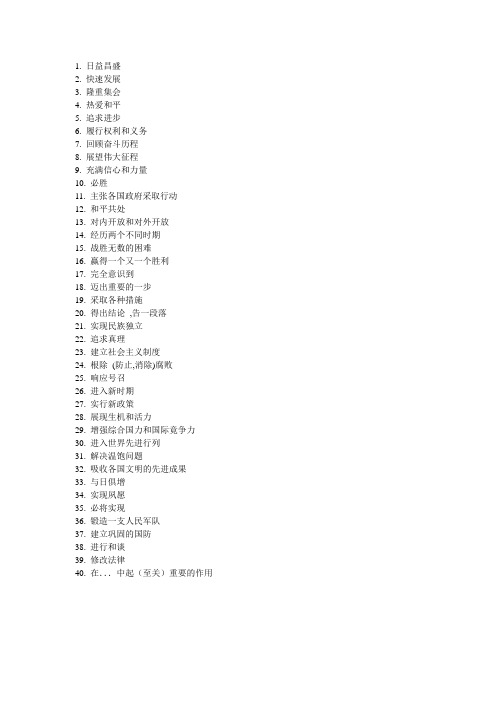
1. 日益昌盛
2. 快速发展
3. 隆重集会
4. 热爱和平
5. 追求进步
6. 履行权利和义务
7. 回顾奋斗历程
8. 展望伟大征程
9. 充满信心和力量
10. 必胜
11. 主张各国政府采取行动
12. 和平共处
13. 对内开放和对外开放
14. 经历两个不同时期
15. 战胜无数的困难
16. 赢得一个又一个胜利
17. 完全意识到
18. 迈出重要的一步
19. 采取各种措施
20. 得出结论,告一段落
21. 实现民族独立
22. 追求真理
23. 建立社会主义制度
24. 根除(防止,消除)腐败
25. 响应号召
26. 进入新时期
27. 实行新政策
28. 展现生机和活力
29. 增强综合国力和国际竟争力
30. 进入世界先进行列
31. 解决温饱问题
32. 吸收各国文明的先进成果
33. 与日俱增
34. 实现夙愿
35. 必将实现
36. 锻造一支人民军队
37. 建立巩固的国防
38. 进行和谈
39. 修改法律
40. 在...中起(至关)重要的作用。
外交声明翻译的标准和方法
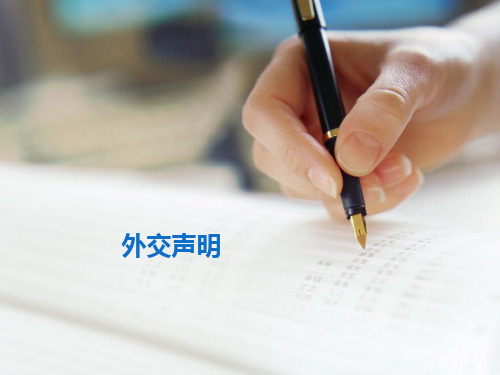
主体 一……二……三……四……五
结尾
六 我们三国领导人一致认为,为保证有效的开展三方合作,必须开拓广 泛的合作渠道。……并向年度领导人会晤提交进展情况报告。
中华人民共和国国务院总理温家宝
落款
国家名称和代表
日本首相小泉纯一郎
时间
语文种类 大韩民国总统卢武铉
2003年10月7日三方用英语签署于印度尼西亚巴厘岛
informative
informative (representing objects and facts)
expressive
expressive (expressing sender’s attitude)
logical
aesthetic
operative
appellative (making an appeal to text receiver)
三因素构成法
《中日韩推进三方合作联合声明》 单位:中Re日pu韩blitcheofPKeoorpelae’s Republic of China, Japan and the 事由:推进三方合作 the Promotion of Tripartite Cooperation 文种:联合声明Joint Declaration
进行的活动:访问、谈判、交涉、发出外交文件、 缔结条约、参加国际会议和国际组织等对外活动。
说法二:外交包括外事。
我国实行总体外交,地方外事是总体外交的组成 部分。
经济、科技、教育、文化等各个领域的外事活动 也都是总体外交的组成部分。
什么是涉外?
涉外是涉外事务的统称。
外事部门:通常指地方专职外事部门,如国际合 作交流处(科)、外事办公室、外事处(科)、 对外联络部等。
外交公报翻译例句及相关词汇
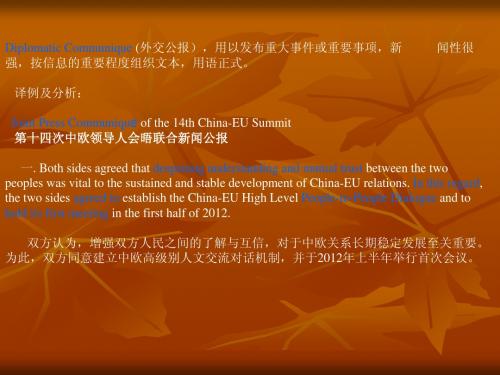
二. Both sides emphasized the importance of promotion and protection of human rights and the rule of law. Both sides looked forward to the strengthening of the China-EU dialogue and cooperation on human rights based on equality and mutual respect and expressed their readiness to work together for constant progress on the ground. Both sides confirmed their commitment to cooperate with UN human rights mechanisms. 双方强调促进和保护人权与法治的重要性。双方期待在平等和相 互尊重的基础上加强在人权领域的对话与合作,愿共同努力推动 对话不断取得切实进展。双方确认将致力于与联合国人权机制开 展合作。
Diplomatic Communique (外交公报),用以发布重大事件或重要事项,新 强,按信息的重要程度组织文本,用语正式。 译例及分析: Joint Press Communiquéof the 14th China-EU Summit 第十四次中欧领导人会晤联合新闻公报
闻性很
一. Both sides agreed that deepening understanding and mutual trust between the two peoples was vital to the sustained and stable development of China-EU relations. In this regard, the two sides agreed to establish the China-EU High Level People-to-People Dialogue and to hold its first meeting in the first half of 2012. 双方认为,增强双方人民之间的了解与互信,对于中欧关系长期稳定发展至关重要。 为此,双方同意建立中欧高级别人文交流对话机制,并于2012年上半年举行首次会议。
中美联合声明(英文版)

U.S. - China Joint Statement1. At the invitation of President Barack Obama of the United States of America, President Hu Jintao of the People’s Republic of China is paying a state visit to the United States of America from January 18-21, 2011. During his visit, President Hu met with Vice President Joseph Biden, will meet with U.S. Congressional leadership, and will visit Chicago.2. The two Presidents reviewed the progress made in the relationship since President Obama’s November 2009 State Visit to China and reaffirmed their commitment to building a positive, cooperative, and comprehensive U.S. - China relationship for the 21st century, which serves the interests of the American and Chinese peoples and of the global community. The two sides reaffirmed that the three Joint Communiqués issued by the United States and China laid the political foundation for the relationship and will continue to guide the development of U.S. - China relations. The two sides reaffirmed respect for each other’s sovereignty and territorial integrity. The Presidents further reaffirmed their commitment to the November 2009 U.S. - China Joint Statement.3. The United States and China committed to work together to build a cooperative partnership based on mutual respect and mutual benefit in order to promote the common interests of both countries and to address the 21st century's opportunities and challenges. The United States and China are actively cooperating on a wide range of security, economic, social, energy, and environmental issues which require deeper bilateral engagement and coordination. The two leaders agreed that broader and deeper collaboration with international partners and institutions is required to develop and implement sustainable solutions and to promote peace, stability, prosperity, and the well-being of peoples throughout the world.Strengthening U.S. - China Relations4. Recognizing the importance of the common challenges that they face together, the United States and China decided to continue working toward a partnership that advances common interests, addresses shared concerns, and highlights international responsibilities. The two leaders recognize that the relationship between the United States and China is both vital and complex. The United States and China have set an example of positive and cooperative relations between countries, despite different political systems, historical and cultural backgrounds, and levels of economic development. The two sides agreed to work further to nurture and deepen bilateral strategic trust to enhance their relations. They reiterated the importance of deepening dialogue aimed at expanding practical cooperation and affirmed the need to work together to address areas of disagreement, expand common ground, and strengthen coordination on a range of issues.5. The United States reiterated that it welcomes a strong, prosperous, and successful China that plays a greater role in world affairs. China welcomes the United States as an Asia-Pacific nation that contributes to peace, stability and prosperity in the region. Working together, both leaders support efforts to build a more stable, peaceful, and prosperous Asia-Pacific region for the 21st century.6. Both sides underscored the importance of the Taiwan issue in U.S. - China relations. The Chinese side emphasized that the Taiwan issue concerns China’s sovereignty and territorial integrity, and expressed the hope that the U.S. side will honor its relevant commitments and appreciate and support the Chinese side’s position on this issue. The U.S. side stated that the United States follows its one China policy and abides by the principles of the three U.S.-China Joint Communiqués. The United States applauded the Economic Cooperation Framework Agreement between the two sides of the Taiwan Strait and welcomed the new lines of communications developing between them. The United States supports the peaceful development of relations across the Taiwan Strait and looks forward to efforts by both sides to increase dialogues and interactions in economic, political, and other fields, and to develop more positive and stable cross-Strait relations.7. The United States and China reiterated their commitment to the promotion and protection of human rights, even as they continue to have significant differences on these issues. The United States stressed that the promotion of human rights and democracy is an important part of its foreign policy. China stressed that there should be no interference in any country’s internal affairs. The United States and China underscored that each country and its people have the right to choose their own path, and all countries should respect each other's choice of a development model. Addressing differences on human rights in a spirit of equality and mutual respect, as well as promoting and protecting human rights consistent with international instruments, the two sides agreed to hold the next round of the U.S.- C hina Human Rights Dialogue before the third round of the Strategic and Economic Dialogue (S&ED).8. The United States and China agreed to hold the next round of the resumed Legal Experts Dialogue before the next Human Rights Dialogue convenes. The United States and China further agreed to strengthen cooperation in the field of law and exchanges on the rule of law. The United States and China are actively exploring exchanges and discussions on the increasing role of women in society.9. The United States and China affirmed that a healthy, stable, and reliable military-to-military relationship is an essential part of President Obama’s and President Hu’s shared vision for a positive, cooperative, and comprehensive U.S.-China relationship. Both sides agreed on the need for enhanced and substantive dialogue and communication at all levels: to reduce misunderstanding, misperception, and miscalculation; to foster greater understanding and expand mutual interest; and to promote the healthy, stable, and reliable development of the military-to-militaryrelationship. Both sides noted the successful visit of Secretary of Defense Robert Gates to China earlier this month, and that the United States welcomes Chief of the PLA General Staff General Chen Bingde to the United States in the first half of 2011. Both sides reaffirmed that the Defense Consultative Talks, the Defense Policy Coordination Talks, and the Military Maritime Consultative Agreement will remain important channels of communication in the future. Both sides will work to execute the seven priority areas for developing military-to-military relations as agreed to by Secretary Gates and General Xu Caihou, Vice Chairman of the Central Military Commission in October 2009.10. The United States and China agreed to take specific actions to deepen dialogue and exchanges in the field of space. The United States invited a Chinese delegation to visit NASA headquarters and other appropriate NASA facilities in 2011 to reciprocate for the productive visit of the U.S. NASA Administrator to China in 2010. The two sides agreed to continue discussions on opportunities for practical future cooperation in the space arena, based on principles of transparency, reciprocity, and mutual benefit.11. The United States and China acknowledged the accomplishments under the bilateral Agreement on Cooperation in Science and Technology, one of the longest-standing bilateral agreements between the two countries, and welcomed the signing of its extension. The United States and China will continue to cooperate in such diverse areas as agriculture, health, energy, environment, fisheries, student exchanges, and technological innovation in order to advance mutual well-being.12. The United States and China welcomed progress by the U.S.-China Joint Liaison Group on Law Enforcement Cooperation (JLG) to strengthen law enforcement cooperation across a range of issues, including counterterrorism. The United States and China also agreed to enhance joint efforts to combat corruption through bilateral and other means.Promoting High-Level Exchanges13. The two sides agreed that high-level exchanges are indispensable to strong U.S.-China relations, and that close, frequent, and in-depth dialogue is important to advance bilateral relations and international peace and development. In this spirit, both Presidents look forward to meeting again in the coming year, including in the state of Hawaii for the U.S.-hosted 2011 Asia-Pacific Economic Cooperation (APEC) Leaders’meeting. China welcomed Vice President Biden for a visit in 2011. The United States welcomed a subsequent visit by Vice President Xi Jinping.14. The two sides praised the S&ED as a key mechanism for coordination between the two governments, and agreed to hold the third round of the S&ED in Washington, D.C., in May 2011. The S&ED has played an important role in helping build trust and confidence between the two countries. The two sides also agreed to hold the second meeting of the High-Level Consultation on People-to-People Exchange in the United States in the springof 2011, and the 22nd meeting of the U.S.-China Joint Commission on Commerce and Trade (JCCT) in China in the second half of 2011. The two sides agreed to maintain close communication between the foreign ministers of the two countries through mutual visits, meetings, and other means.15. The two sides emphasized the importance of continued interaction between their legislatures, including institutionalized exchanges between the National People’s Congress of China and the U.S. Senate and House of Representatives.Addressing Regional and Global Challenges16. The two sides believe that the United States and China have a common interest in promoting peace and security in the Asia-Pacific region and beyond, and agreed to enhance communication and coordination to address pressing regional and global challenges. The two sides undertake to act to protect the global environment and to work in concert on global issues to help safeguard and promote the sustainable development of all countries and peoples. Specifically, the United States and China agreed to advance cooperation to: counter violent extremism; prevent the proliferation of nuclear weapons, other weapons of mass destruction, and their means of delivery; strengthen nuclear security; eliminate infectious disease and hunger; end extreme poverty; respond effectively to the challenge of climate change; counter piracy; prevent and mitigate disasters; address cyber-security; fight transnational crime; and combat trafficking in persons. In coordination with other parties, the United States and China will endeavor to increase cooperation to address common concerns and promote shared interests.17. The United States and China underlined their commitment to the eventual realization of a world without nuclear weapons and the need to strengthen the international nuclear non-proliferation regime to address the threats of nuclear proliferation and nuclear terrorism. In this regard, both sides support early entry into force of the Comprehensive Nuclear Test Ban Treaty (CTBT), reaffirmed their support for the early commencement of negotiations on a Fissile Material Cutoff Treaty in the Conference on Disarmament, and agreed to work together to reach these goals. The two sides also noted their deepening cooperation on nuclear security following the Washington Nuclear Security Summit and signed a Memorandum of Understanding that will help establish a Center of Excellence on Nuclear Security in China.18. The United States and China agreed on the critical importance of maintaining peace and stability on the Korean Peninsula as underscored by the Joint Statement of September 19, 2005 and relevant UN Security Council Resolutions. Both sides expressed concern over heightened tensions on the Peninsula triggered by recent developments. The two sides noted their continuing efforts to cooperate closely on matters concerning the Peninsula. The United States and China emphasized the importance of an improvement in North-South relations and agreed that sincere and constructiveinter-Korean dialogue is an essential step. Agreeing on the crucial importance of denuclearization of the Peninsula in order to preserve peace and stability in Northeast Asia, the United States and China reiterated the need for concrete and effective steps to achieve the goal of denuclearization and for full implementation of the other commitments made in the September 19, 2005 Joint Statement of the Six-Party Talks. In this context, the United States and China expressed concern regarding the DPRK’s claimed uranium enrichment program. Both sides oppose all activities inconsistent with the 2005 Joint Statement and relevant international obligations and commitments. The two sides called for the necessary steps that would allow for early resumption of the Six-Party Talks process to address this and other relevant issues.19. On the Iranian nuclear issue, the United States and China reiterated their commitment to seeking a comprehensive and long-term solution that would restore international confidence in the exclusively peaceful nature of Iran’s nuclear program. Both sides agreed that Iran has the right to peaceful uses of nuclear energy under the Non-Proliferation Treaty and that Iran should fulfill its due international obligations under that treaty. Both sides called for full implementation of all relevant UN Security Council Resolutions. The United States and China welcomed and will actively participate in the P5+1 process with Iran, and stressed the importance of all parties –including Iran –committing to a constructive dialogue process.20. Regarding Sudan, the United States and China agreed to fully support the North-South peace process, including full and effective implementation of Sudan’s Comprehensive Peace Agreement. The two sides stressed the need for all sides to respect the result of a free, fair, and transparent referendum. Both the United States and China expressed concern on the Darfur issue and believed that further, substantive progress should be made in the political process in Darfur to promote the early, comprehensive, and appropriate solution to this issue. Both the United States and China have a continuing interest in the maintenance of peace and stability in the wider region.21. The two sides agreed to enhance communication and coordination in the Asia-Pacific region in a spirit of mutual respect and cooperation, and to work together with other Asia-Pacific countries, including through multilateral institutions, to promote peace, stability, and prosperity.Building a Comprehensive and Mutually Beneficial Economic Partnership22. President Obama and President Hu recognized the vital importance of working together to build a cooperative economic partnership of mutual respect and mutual benefit to both countries and to the global economy. The two leaders agreed to promote comprehensive economic cooperation, and will develop further a framework of comprehensive economic cooperation, relying on existing mechanisms, by the third round of the S&ED in May, based on the main elements outlined below:23. The two sides agreed to strengthen macroeconomic communication and cooperation, in support of strong, sustainable and balanced growth in the United States, China and the global economy:∙The United States will focus on reducing its medium-term federal deficit and ensuring long-term fiscal sustainability, and will maintain vigilance against excess volatility in exchange rates. The Federal Reserve has taken important steps in recent years to increase the clarity of its communications regarding its outlook and longer run objectives.∙China will intensify efforts to expand domestic demand, to promote private investment in the service sector, and to give greater play to the fundamental role of the market in resource allocation. China will continue to promote RMB exchange rate reform and enhance RMB exchange rate flexibility, and promote the transformation of its economic development model.∙Both sides agree to continue to pursue forward-looking monetary policies with due regards to the ramifications of those policies for the international economy.∙The two sides affirmed support for efforts by European leaders to reinforce market stability and promote sustainable, long-term growth.24. The two countries, recognizing the importance of open trade and investment in fostering economic growth, job creation, innovation, and prosperity, affirmed their commitment to take further steps to liberalize global trade and investment, and to oppose trade and investment protectionism. The two sides also agreed to work proactively to resolve bilateral trade and investment disputes in a constructive, cooperative, and mutually beneficial manner.25. The two leaders emphasized their strong commitment to direct their negotiators to engage in across-the-board negotiations to promptly bring the WTO Doha Development Round to a successful, ambitious, comprehensive, and balanced conclusion, consistent with the mandate of the Doha Development Round and built on the progress already achieved. The two sides agreed that engagement between our representatives must intensify and expand in order to complete the end game.26. The two leaders agreed on the importance of achieving a more balanced trade relationship, and spoke highly of the progress made on this front, including at the recent 21st Meeting of the JCCT in Washington, D.C.27. China will continue to strengthen its efforts to protect IPR, including by conducting audits to ensure that government agencies at all levels use legitimate software and by publishing the auditing results as required by China’s law. China will not link its innovation policies to the provision of government procurement preferences. The United States welcomed China’s agreement to submit a robust, second revised offer to the WTO Government Procurement Committee before the Committee’s final meeting in 2011, which will include sub-central entities.28. The two leaders acknowledged the importance of fostering open, fair, and transparent investment environments to their domestic economies and to the global economy and reaffirmed their commitment to the ongoing bilateral investment treaty (BIT) negotiations, recognizing that a successful BIT negotiation would support an open global economy by facilitating and protecting investment, and enhancing transparency and predictability for investors of both countries. China welcomed the United States’commitment to consult through the JCCT in a cooperative manner to work towards China’s Market Economy Status in an expeditious manner. China welcomed discussion between the two sides on the ongoing reform of the U.S. export control system, and its potential implications for U.S. exports to its major trading partners, including China, consistent with U.S. national security interests.29. The two sides further acknowledged the deep and robust nature of the commercial relationship, including the contracts concluded at this visit, and welcomed the mutual economic benefits resulting from the relationship.30. The two sides agreed to continue working to make concrete progress on the bilateral economic relationship through the upcoming S&ED and the JCCT process.31. The United States and China recognized the potential for their firms to play a positive role in the infrastructure development in each country and agreed to strengthen cooperation in this area.32. The two countries committed to deepen bilateral and multilateral cooperation on financial sector investment and regulation, and support open environments for investment in financial services and cross-border portfolio investment, consistent with prudential and national security requirements. The United States is committed to ensuring that the GSEs have sufficient capital and the ability to meet their financial obligations.33. The United States and China agree that currencies in the SDR basket should only be those that are heavily used in international trade and financial transactions. In that regard, the United States supports China’s efforts over time to promote inclusion of the RMB in the SDR basket.34. The two countries pledged to work together to strengthen the global financial system and reform the international financial architecture. The two sides will continue their strong cooperation to strengthen the legitimacy and improve the effectiveness of the International Monetary Fund and Multilateral Development Banks (MDBs). The two sides will jointly promote efforts of the international community to assist developing countries, in particular the Least Developed Countries to achieve the Millennium Development Goals (MDGs). The two sides will also, in partnership with the Multilateral Development Banks, explore cooperation that supports global poverty reduction and development, and regional integration including in Africa, to contribute to inclusive and sustainable economic growth.35. The two countries reiterated their support for the G-20 Framework for Strong, Sustainable and Balanced Growth and reaffirmed their commitments made in the Seoul Summit Declaration, including using the full range of policies to strengthen the global recovery and to reduce excessive imbalances and maintain current account imbalances at sustainable levels. The two sides support a bigger role for the G-20 in international economic and financial affairs, and pledged to strengthen communication and coordination to follow through on the commitments of the G-20 summits and push for positive outcomes at the Cannes Summit.Cooperating on Climate Change, Energy and the Environment36. The two sides view climate change and energy security as two of the greatest challenges of our time. The United States and China agreed to continue their close consultations on action to address climate change, coordinate to achieve energy security for our peoples and the world, build on existing clean energy cooperation, ensure open markets, promote mutually beneficial investment in climate friendly energy, encourage clean energy, and facilitate advanced clean energy technology development.37. Both sides applauded the progress made in clean energy and energy security since the launch of the U.S.-China Clean Energy Research Center, Renewable Energy Partnership, U.S.-China Joint Statement on Energy Security Cooperation, and Energy Cooperation Program (ECP). Both sides reaffirmed their ongoing exchanges on energy policy and cooperation on oil, natural gas (including shale gas), civilian nuclear energy, wind and solar energy, smart grid, advanced bio-fuels, clean coal, energy efficiency, electric vehicles and clean energy technology standards.38. The two sides commended the progress made since the launch of the U.S.-China Ten Year Framework on Energy and Environment Cooperation (TYF) in 2008. They agreed to further strengthen practical cooperation under the TYF, carry out action plans in the priority areas of water, air, transportation, electricity, protected areas, wetlands, and energy efficiency, engage in policy dialogues, and implement the EcoPartnerships program. The United States and China were also pleased to announce two new EcoPartnerships. The two sides welcomed local governments, enterprises, and research institutes of the two countries to participate in the TYF, and jointly explore innovative models for U.S.-China energy and environment cooperation. The two sides welcomed the cooperation projects and activities which will be carried out in 2011 under the TYF.39. The two sides welcomed the Cancun agreements and believed that it is important that efforts to address climate change also advance economic and social development. Working together and with other countries, the two sides agreed to actively promote the comprehensive, effective, and sustained implementation of the United Nations Framework Convention on Climate Change, including the implementation of the Cancun agreementsand support efforts to achieve positive outcomes at this year’s conference in South Africa.Expanding People-to-People Exchanges40. The United States and China have long supported deeper and broader people-to-people ties as part of a larger effort to build a cooperative partnership based on mutual respect and mutual benefit. Both sides agreed to take concrete steps to enhance these people-to-people exchanges. Both sides noted with satisfaction the successful Expo 2010 Shanghai, and the Chinese side complimented the United States on its USA Pavilion. The two sides announced the launch of a U.S.-China Governors Forum and decided to further support exchanges and cooperation at local levels in a variety of fields, including support for the expansion of the sister province and city relationships. The United States and China also agreed to take concrete steps to strengthen dialogue and exchanges between their young people, particularly through the 100,000 Strong Initiative. The United States warmly welcomes more Chinese students in American educational institutions, and will continue to facilitate visa issuance for them. The two sides agreed to discuss ways of expanding cultural interaction, including exploring a U.S.-China cultural year event and other activities. The two sides underscored their commitment to further promoting and facilitating increased tourism. The United States and China agreed that all these activities help deepen understanding, trust, and cooperation.Conclusion41. President Hu Jintao expressed his thanks to President Obama and the American people for their warm reception and hospitality during his visit. The two Presidents agreed that the visit has furthered U.S.-China relations, and both sides resolved to work together to build a cooperative partnership based on mutual respect and mutual benefit. The two Presidents shared a deep belief that a stronger U.S.-China relationship not only serves the fundamental interests of their respective peoples, but also benefits the entire Asia-Pacific region and the world.。
外交词汇翻译合集
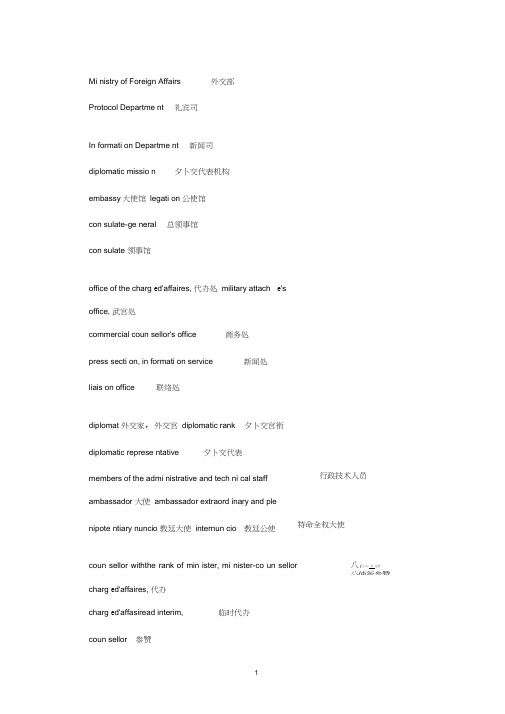
Mi nistry of Foreign Affairs 外交部Protocol Departme nt 礼宾司In formati on Departme nt 新闻司diplomatic missio n 夕卜交代表机构embassy大使馆legati on 公使馆con sulate-ge neral 总领事馆con sulate 领事馆office of the charg e d'affaires, 代办处military attach e's office, 武官处commercial coun sellor's office 商务处press secti on, in formati on service 新闻处liais on office 联络处diplomat 外交家,外交官diplomatic rank 夕卜交官衔diplomatic represe ntative 夕卜交代表members of the admi nistrative and tech ni cal staff ambassador 大使ambassador extraord inary and ple nipote ntiary nuncio 教廷大使internun cio 教廷公使coun sellor withthe rank of min ister, mi nister-co un sellor charg e d'affaires, 代办charg e d'affasiread interim, 临时代办coun sellor 参赞行政技术人员特命全权大使八【土/片.牛.氏肚公使衔参赞sec ond secretary二等秘书third secretary 三等秘书 attach e ,随员commercial secretary 商务参赞cultural secretary 文化参赞 commercial attach e , 商务专员 cultural attach e ,文化专员 military attache ,武官naval attach e 海军武官 air attach e ,空军武官con sul-ge neral 总领事 con sul 领事doye n of the diplomatic corps, dea n of the diplomatic corps roving ambassador 巡回大使 ambassador-at-large 无任所大使special en voy特使accredited to ... 向…派遣的 foreig n affairs夕卜交memorandum, aidememoire 备忘录persona non-grat 不受欢迎的人de jure recog niti on法律承认first secretary 等秘书 外交使团团长com mnique 公报announcement 公告,通告letter of crede nee, crede ntials 国书mutual recog niti on互相承认establishme nt of diplomatic relati onsstateme nt 声明 de facto recog niti on 事实上承认persona grata 受欢迎的人 diplomatic practice 夕卜交惯例 diplomatic immun ities夕卜交豁免 letter of appo in tme nt 委任书 certificate of appo in tme nt 委任证书exequatur 许可证书 declarati on, mani festo 宣扬letter of recall 召回公文note 照会 verbal note普通照会circular note 通知照会 formal n ote 正式照会 no rmalizati on 正常化be appo in ted ambassador to ... 被任命为驻 …大使to express regret 表示遗憾 to sever diplomatic relati ons断绝外交关系to resume charge of the office, to return to on e's post返任letter of in troduct ion 介绍书 duri ng on e's abse nee 离任期间 identification card身份证建立外交关系to proceed to take up on e's post 赴任to excha nge ambassadors 互派大使to resume diplomatic relati ons 恢复外交关系to establish diplomatic relati ons at ambassadorial level 建立大使级外交关系to establish con sular relati ons 建立领事关系to assume on e's post 就任to take exceptio n to; to object to 提出异议to upgrade diplomatic relati ons 夕卜交关系升格to make representations to, to take up a (the) matter with 向•-交涉to lodge a protest with 向…提出抗议to request the consent of... 征求…的同意to suspe nd diplomatic relati ons 中断外交关系tea party 茶会an atmosphere of cordiality and frien dship 诚挚友好的气氛reciprocal banq uet 答谢宴会delegatio n 代表团head of the delegatio n, leader of the delegatio n 团长deputy head of the delegati on, deputy leader of the delegatio n 副团长member of the delegati on 代表团成员memorial speech 悼词to develop the relati ons offrie ndship and cooperati on 发展友好合作关系prosperity and stre ngth 繁荣富强visit 访问frie ndly visit, goodwill visit 友好访问in formal visit 非正式访问official visit 正式访问state visit 国事访问obituary 讣告message of greeti ng, message of con gratulati on 贺电speech of welcome 欢迎词 profound con dole nee 深切哀悼 cordial hospitality盛情接待the two sides, the two parties 双方lun che on 午宴message of con dole nee 唁电 to convey on e's sympathy 表示慰问to review the guard of honour 检阅仪仗队to be shocked to lear n of 惊悉on the happy occasi on of 欣逢 on lear ning with great joy 欣悉 to give a banquet in honour of... 宴请 … on in vitatio n, upon in vitati on 应邀at the in vitatio n of...应…邀请in the compa ny of..., accompa nied by...在…陪同下to express on e's sincere con gratulati ons and best wishes 好的愿望to wish prosperity to a country and well-be ing to its people 繁荣人民幸福to take n ote of...注意至 UHis (Her, Your) Majesty 陛下 His (Her, Your) Royal High ness殿下private visit 私人访问 致以衷心的祝贺和最祝(某国)国家His (Her, Your) Excelle ncy 阁下His excelle ncy Mr. Preside nt and Mme...…总统先生阁下和夫人欢迎您的下载,资料仅供参考!致力为企业和个人提供合同协议,策划案计划书,学习资料等等打造全网一站式需求。
联合国外交发言稿英文翻译
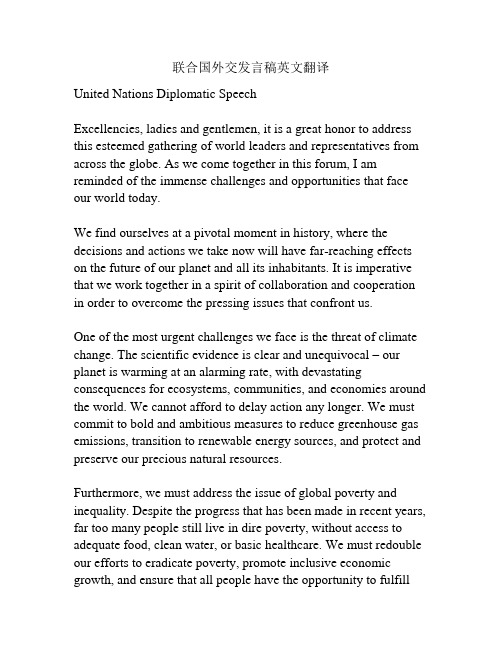
联合国外交发言稿英文翻译United Nations Diplomatic SpeechExcellencies, ladies and gentlemen, it is a great honor to address this esteemed gathering of world leaders and representatives from across the globe. As we come together in this forum, I am reminded of the immense challenges and opportunities that face our world today.We find ourselves at a pivotal moment in history, where the decisions and actions we take now will have far-reaching effects on the future of our planet and all its inhabitants. It is imperative that we work together in a spirit of collaboration and cooperation in order to overcome the pressing issues that confront us.One of the most urgent challenges we face is the threat of climate change. The scientific evidence is clear and unequivocal – our planet is warming at an alarming rate, with devastating consequences for ecosystems, communities, and economies around the world. We cannot afford to delay action any longer. We must commit to bold and ambitious measures to reduce greenhouse gas emissions, transition to renewable energy sources, and protect and preserve our precious natural resources.Furthermore, we must address the issue of global poverty and inequality. Despite the progress that has been made in recent years, far too many people still live in dire poverty, without access to adequate food, clean water, or basic healthcare. We must redouble our efforts to eradicate poverty, promote inclusive economic growth, and ensure that all people have the opportunity to fulfilltheir potential and live with dignity.In addition to these pressing global challenges, we must also confront the scourge of conflict and instability. Too many people around the world are suffering as a result of violent conflict and war. We must work tirelessly to support peace and stability, protect human rights, and promote the rule of law. This requires genuine dialogue and diplomacy, as well as a commitment to addressing the root causes of conflict and finding peaceful and sustainable solutions.As we gather here today, we must remember that the United Nations was founded on the principles of peace, cooperation, and mutual respect. It is our shared responsibility to uphold and advance these principles in the face of the complex and interconnected challenges that confront us.In closing, I would like to reiterate the importance of unity and solidarity in addressing the urgent issues that face our world today. The United Nations provides a vital forum for dialogue and cooperation, and it is essential that we work together in a spirit of partnership and collaboration. By doing so, we can build a better future for all people, and ensure that our planet remains a safe and sustainable home for generations to come.Thank you.。
外交辞令翻译
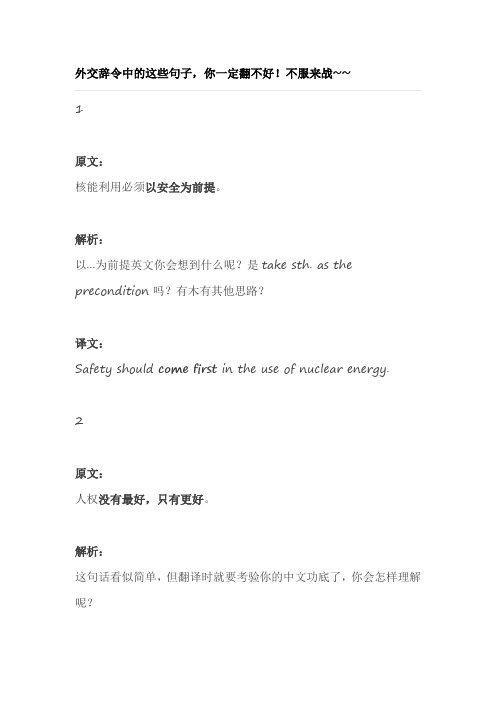
外交辞令中的这些句子,你一定翻不好!不服来战~~1原文:核能利用必须以安全为前提。
解析:以...为前提英文你会想到什么呢?是take sth. as the precondition吗?有木有其他思路?译文:Safety should come first in the use of nuclear energy.2原文:人权没有最好,只有更好。
解析:这句话看似简单,但翻译时就要考验你的中文功底了,你会怎样理解呢?译文:When it comes to human rights, there is always room for improvement.3原文:世界上没有放之四海而皆准的人权发展道路。
解析:这句话呢,是不是看到后直接想放弃的心都有?还是不说了,先学吧~~译文:There is no one-size-fits-all model for the development of human rights.4原文:中国高度重视农业和农村可持续发展,始终坚持立足自身解决口粮问题。
解析:这句话要注意后面部分"坚持立足自身解决口粮问题",翻译技巧是将抽象的概念具体化,看看官方是怎么处理的吧?译文:China attaches great importance to sustainable agricultural and rural development. China has always managed to ensure basic food supply by relying on domestic production.5原文:中方坚持实现朝鲜半岛无核化,坚持维护半岛和平稳定,坚持通过对话协商解决问题。
解析:翻译时,这句话需要注意三个坚持的关系,考虑是否可以合并翻译?另外还要注意"问题"的翻译!译文:China is committed to a denuclearized, peaceful and stable Korean Peninsula and settlement of relevant issues through dialogue and consultation.6原文:半岛有关问题最终解决,要综合施策,对症下药。
旧护照声明中文和英文版本
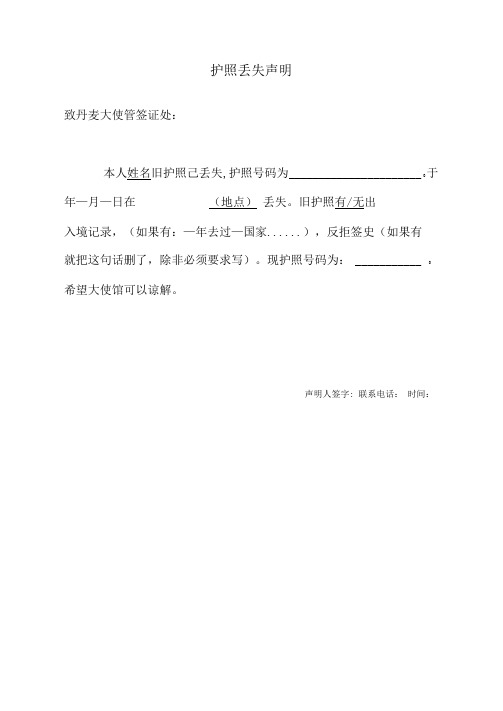
护照丢失声明
致丹麦大使管签证处:
本人姓名旧护照己丢失,护照号码为______________________ O于年—月—日在(地点)丢失。
旧护照有/无出
入境记录,(如果有:—年去过—国家......),反拒签史(如果有
就把这句话删了,除非必须要求写)。
现护照号码为:___________ O 希望大使馆可以谅解。
声明人签字: 联系电话:时间:
Lost Passport Statement
Date: 1st January 2012(例子,写当天日期)
To: Embassy of Denmark (例子,写所要去的国家)
Attn: Visa Section
Dear Visa Officer:
My name is ________ I lost my former
passport ,NO. ______________ , in (where)_______ on ___ (when). And the visa/visas issued and period is/are:例如:US2012,FR2012 等(国家缩写+年).There was no visa refusals (如果有拒签史就删掉这句话)・My present passport NO. .Thanks for your kindness.
Sign:
Contact number:。
第三单元 外交声明的翻译
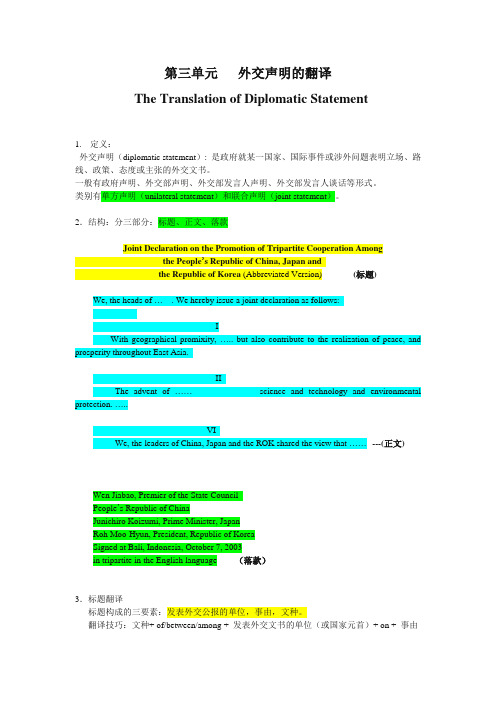
第三单元外交声明的翻译The Translation of Diplomatic Statement1.定义:外交声明(diplomatic statement): 是政府就某一国家、国际事件或涉外问题表明立场、路线、政策、态度或主张的外交文书。
一般有政府声明、外交部声明、外交部发言人声明、外交部发言人谈话等形式。
类别有单方声明(unilateral statement)和联合声明(joint statement)。
2.结构:分三部分:标题、正文、落款Joint Declaration on the Promotion of Tripartite Cooperation Amongthe People’s Republic of China, Japan andthe Republic of Korea (Abbreviated Version) ------- (标题)We, the heads of …. We hereby issue a joint declaration as follows:IWith geographical promixity, ….. but also contribute to the realization of peace, and prosperity throughout East Asia.IIThe advent of ……science and technology and environmental protection. …..VIWe, the leaders of China, Japan and the ROK shared the view that ……-----(正文)Wen Jiabao, Premier of the State CouncilPeople’s Republic of ChinaJunichiro Koizumi, Prime Minister, JapanRoh Moo-Hyun, President, Republic of KoreaSigned at Bali, Indonesia, October 7, 2003in tripartite in the English language ----(落款)3.标题翻译标题构成的三要素:发表外交公报的单位,事由,文种。
